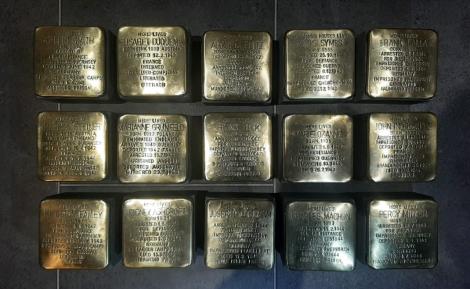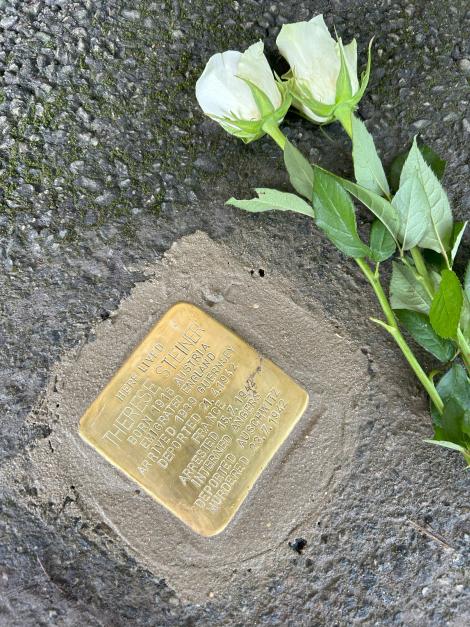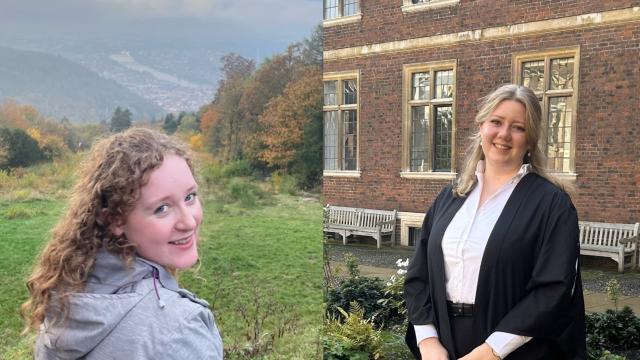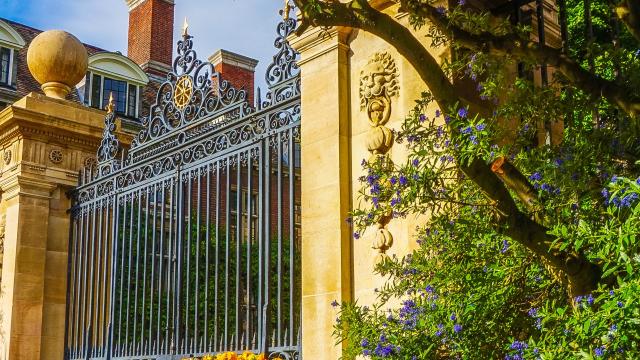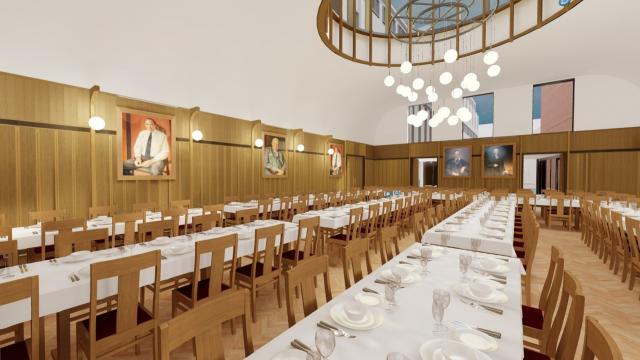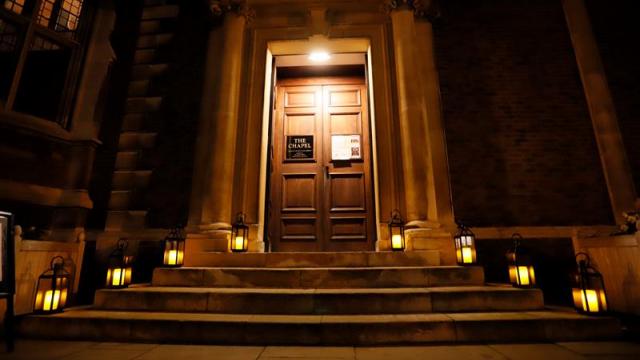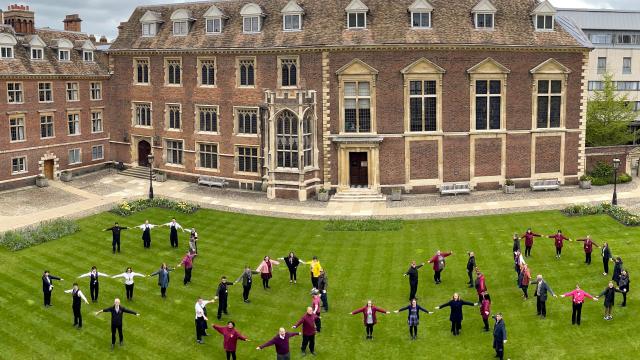
A Fellow of St Catharine’s dedicated time this July to continuing research and public engagement activities to ensure that victims and survivors of Nazism are remembered. Dr Gilly Carr (2006), Director of Studies in Archaeology at St Catharine’s, was invited to two Holocaust heritage sites in the Czech Republic (also known as Czechia) and, after months of careful preparations, to the installation of 35 new Stolpersteine in the Channel Islands commemorating the names and lives of victims and survivors of Nazism.
Dr Carr, who has been promoted by the University of Cambridge to Professor of Conflict Archaeology and Holocaust Heritage from October and also serves as a member of the UK delegation of the International Holocaust Remembrance Alliance (IHRA), said:
“It is vital to safeguard Holocaust heritage sites and commemorate victims and survivors of Nazi persecution so future generations can continue to acknowledge suffering in the past and to remember and pay their respects in the present. The families whose members were honoured with Stolpersteine in the Channel Islands were very moved and happy to have their loved ones remembered in this way. Those involved in the project were honoured and proud to have been part of it.”
Learning from Holocaust heritage sites
Dr Carr was invited by Dr Pavel Vařeka, Associate Professor and Head of the Department of Archaeology at the University of West Bohemia in Pilsen, to join him for two weeks to excavate Holocaust heritage sites at Svatava and Kaštice, located about 40 miles apart in western Czechia.
Svatava is the site of a women’s concentration camp, a sub-camp of Flossenbürg located the other side of the border with Germany. More than 2,000 women passed through Svatava between 1943 and the camp’s liberation in 1945, when American armed forces demolished and burned down the camp to prevent the spread of typhus. This summer’s excavation was focused on the well-preserved remains of the kitchens, since a large area of the site was built over in the post-war period.
Dr Vařeka said, “The geophysical survey revealed well-preserved subsurface remains of the camp kitchen, which our archaeological research focuses on. We want to obtain material evidence of the living conditions in the camp and artifacts that can provide tangible testimony about the prisoners."
Only a few centimetres beneath the soil at Svatava, the team of archaeologists found barbed wire, ceramic insulators from the barbed wire fence, a bullet cartridge, window glass and a bolt from a Mannlicher rifle, all what Dr Carr calls “the materiality of imprisonment”. Towards the end of the dig, the team organised an open day so the local community and media could learn about what was found and the camp’s history.
Dr Carr reflected, “I am grateful to Pavel and his team for the opportunity to join their excavation at Svatava and I am confident that plans for this small site can set the standard for other communities to emulate. The dig involved hard manual labour from the archaeologists amidst a heatwave and even a flash flood, and my thoughts turned to the forced labourers who worked longer hours on this site with less food and less sleep, day in, day out.”
In addition to the excavation at Svatava, Dr Carr helped to survey execution sites in the woods at Kaštice, where 268 people were killed outright at the end of a Nazi death march in 1945, of whom a third were Jewish. The purpose was to search for the location of mass graves exhumed at the end of the Second World War. Dr Carr first learned about the site in 2016 when she worked with Dr Vařeka to locate the burial of Joseph Tierney, a man from Jersey whose body ended up in the woods before being exhumed and reburied in the nearby hamlet of Pšov.
Dr Carr added, “Working deep in the dense woods on sloping terrain wasn’t easy, but we found bullets and rifle cartridges, and personal objects like a belt and toothpaste tube in the woods. With each new cartridge, Pavel let out a deeper sigh. This sort of work triggers a range of emotions, but overall we are powered by the moral necessity of finding out what happened to the victims of Nazi crimes. We do our work for them.”
Public engagement in the Channel Islands
Dr Carr also worked over the last year to bring 35 Stolpersteine to the Channel Islands. Stolpersteine were created by the studio of German artist Gunter Demnig, and are 10cm by 10cm concrete cubes topped by brass caps stating the name and life dates of victims and survivors of Nazism. They are laid into pavements outside the last freely-chosen address of those they commemorate before their arrest or deportation; over 106,000 have been laid across mainland Europe. ‘Stolpersteine’ translates as ‘stumbling stone’, but these stones are laid flush with the surface of pavements.
Dr Carr explained, “Until this year, there was just one Stolpersteine in the British Isles – in Golden Square, London, laid for Jewish Dutch woman Ada Van Dantzig in May 2022. Memorials with names, like Stolpersteine, can be incredibly meaningful for local communities but also for the families of the individuals’ named. You ‘stumble’ across Stolpersteine, as Demnig puts it, ‘with your heart and head’ and are encouraged remember people and their acts – of protest, defiance and resistance, and of bravery in the face of persecution.”
The Channel Island Stolpersteine – 20 in Jersey and 15 in Guernsey – came about after Dr Carr proposed the idea to Demnig when they were both speaking at an event at the Wiener Holocaust Library to mark the occasion of the London Stolperstein-laying in 2022.
The Stolpersteine in Jersey were laid, in all but two instances, for survivors to ensure no crossover with the purpose of other memorials in the island which commemorate the 21 women and men who died in Nazi prisons, forced labour camps and concentration camps.
Chris Addy of Jersey Heritage, who oversaw the stone laying in the larger island, said:
“The Jersey stones will raise awareness of Islanders who were persecuted for their Jewish heritage or went into hiding for that reason; those convicted of acts of resistance and defiance, including those caught while attempting to escape from the island; individuals sent to Alderney as forced labourers; or interned in Germany for being English born.”
In Guernsey, the Stolpersteine were laid to eight Islanders who died in Nazi prisons and camps for acts of resistance and defiance; three Jewish women without protective British citizenship, deported to France in 1942 and later murdered in Auschwitz; and a Viennese-born Jewish islander with British citizenship who was deported to civilian internment camps and survived. Another stone was laid in memory of Frank Falla, who survived Nazi prisons and later campaigned for compensation for all Channel Islanders who were victims of Nazism. The final two stones were laid for Frank Tuck and Kingston Bailey, two of 16 policemen who were deported to Nazi camps in 1942 for stealing food from German stores and distributing it to starving Islanders. None of the 16 men have had their sentences overturned or received an official apology from the States of Guernsey and so these stones act as a reminder of the legitimacy of their cause.
Helen Glencross, Head of Heritage Services in Guernsey, who organised the installations in that island, said:
“Guernsey Museums is honoured to be part of the Stolpersteine project. Logistically it has been challenging and I am very grateful to all those who have assisted. I hope that the Stolpersteine will raise awareness with islands and visitors about those who were victims and survivors of Nazism during the Second World War.”
Dr Carr added, “I am thrilled to have brought Gunter Demnig and the Stolpersteine project to the Channel Islands, something that I have long hoped for. Each stone is so eloquent; they are quietly defiant. They say, “You deported me but I’m back home and here to stay. I belong here.” They also speak of pride and of acknowledgement that those deported did no wrong. I am proud to have been involved in this project and I hope it won’t be too long till we can bring more Stolpersteine to the Channel Islands.”


